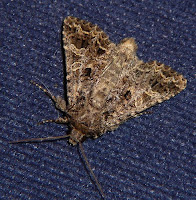Of course, this is the problem faced by many plants. Some of the most successful, flowering plants, use animals to overcome this. But the addition of pollinators into the reproductive mix doesn’t change that there are differences in the interests of male and female plants. As in many animals. males are thought to be capable of producing more gametes, so gain greater reproductive success by dispersing as much pollen as possible.
 Wealti and colleagues examine whether those different reproductive interests of male and female flowers translate into how the flowers attract pollinators. They used a white campion (Silene latifolia), which has lychnis, a nighttime moth (Hadena bicruris) as one of its main pollinators. The females of this moth lay its eggs in the seeds of the plant.
Wealti and colleagues examine whether those different reproductive interests of male and female flowers translate into how the flowers attract pollinators. They used a white campion (Silene latifolia), which has lychnis, a nighttime moth (Hadena bicruris) as one of its main pollinators. The females of this moth lay its eggs in the seeds of the plant.The predictions are first, that male flowers should put more “effort” into attracting pollinators than females, and that this should actually work. That is, the moths should be more attracted to male than female flowers.
Because this is a nocturnal moth, you’d expect that things like flower shape and colour would not matter as much as odour, so that’s what the authors collected: floral fumes! Technically tricky, but once accomplished, they found that the male flowers released more odorants than females. The authors note that the amount of odorants are variable, however; indeed, other studies had looked for this difference, and didn’t find it.
To test the responses of moths to flowers, they reared moths in the laboratory, so the moths had no previous experience with flowers. The male moths were significantly more likely to approach male flowers; the female moths showed no preference.
 Wealti and company say that their results are consistent with the theory, because males more attracted to male flowers. On the other hand, it seems equally valid to say that their results are inconsistent with theory, because females moths are not more attracted to male flowers. That the behaviour of the moths is sex-specific raises interesting questions. The authors suggest that because females lay eggs on female flowers, female moths’ attraction to flowers might depend on the mating status of the females.
Wealti and company say that their results are consistent with the theory, because males more attracted to male flowers. On the other hand, it seems equally valid to say that their results are inconsistent with theory, because females moths are not more attracted to male flowers. That the behaviour of the moths is sex-specific raises interesting questions. The authors suggest that because females lay eggs on female flowers, female moths’ attraction to flowers might depend on the mating status of the females. Whether or not this is the case, it wouldn’t actually explain why unmated females show no preference to male or female flowers. If female moths can change from “no preference” to “preference for female flowers,” there seems to be no strong reason why a change “preference for males flowers” to “preference for female flowers” is somehow less probable.
References
Waelti, M., Page, P., Widmer, A., & Schiestl, F. (2009). How to be an attractive male: floral dimorphism and attractiveness to pollinators in a dioecious plant BMC Evolutionary Biology, 9 (1) DOI: 10.1186/1471-2148-9-190
Flower picture used under a Creative Commons license.
Moth picture by user troubleatmill used under a Creative Commons license.

No comments:
Post a Comment
Comments are moderated. Real names and pseudonyms are welcome. Anonymous comments are not and will be removed.